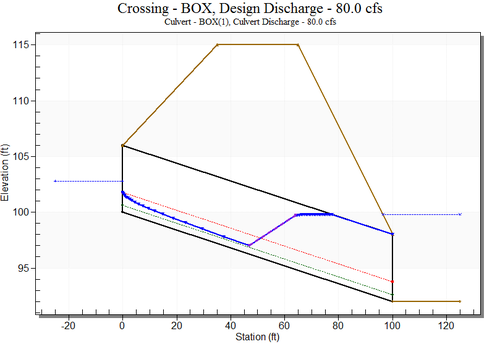HY8:Limitations
Limitations
Inlet and Profile Limitations
Entrance limitations
Since HY-8 is not primarily a water surface profile computation program but is a culvert analysis tool, it assumes a pooled condition at the entrance to the culvert.
Vena contracta assumptions
In some cases, a vena contracta drawdown of the water surface profile could occur in a culvert barrel since the culvert has the potential to act as a sluice gate at the entrance. This drawdown at the entrance is sometimes called a vena contracta. The vena contracta is not yet computed for S2 curves, but is computed for horizontal if certain conditions exist on horizontal or adversely sloped culverts. A coefficient that is generalized for circular and box culverts is used to compute the location and depth of the vena contracta for all culvert shapes.
Brink depth
For culverts with tailwater elevations below the outlet invert of the culvert, water flowing out of the culvert would theoretically pass through a brink depth instead of through critical depth. In this case, HY-8 uses critical depth to determine the final culvert depth and velocity rather than the brink depth.
Culvert cross section
HY-8 assumes the culvert cross section shape, size, and material does not change in the barrel except in the case of broken back runout sections, where you can change the material and Manning's roughness in the runout (lower) culvert section.
Hydraulic Jump Computations
Hydraulic jump computations are supported in HY-8 7.3 and later versions.
Computed outlet velocity and tailwater elevation
The user should be aware that when the tailwater elevation exceeds the elevation of the top of the culvert outlet, the barrel may or may not flow full at the outlet. HY-8 determines a water profile using the direct step method in each direction and the sequent depth associated with each of the steps. If the sequent depth associated with the forward profile matches the depth along the backward profile through the culvert, a hydraulic jump occurs and the length of the jump is calculated from that location. Since the lengths of jumps have not been tested for all culvert sizes and slopes, only a limited set of equations are available for computing the lengths of jumps in HY-8. More information on the jump length computations is available in the section of this manual that describes hydraulic jump computations. A water surface profile for this case is shown below.
In this case, the hydraulic jump length computed by HY-8 may or may not be correct since the equation used to compute hydraulic jump length is for box culverts only, but is applied to all the other possible HY-8 culvert shapes. If a hydraulic jump occurs inside the culvert and the end of the hydraulic jump is located outside the culvert, HY-8 assumes the hydraulic jump occurs outside the culvert and a hydraulic jump is not shown in the profile. If both the beginning and end of the hydraulic jump occur inside the culvert barrel, the hydraulic jump is shown in the profile and is reflected in the profile computations, as shown in the image above.
Culvert Types
Newly supported culvert types
Previous versions of HY-8 did not fully support CON/SPAN culverts, HDPE culverts, or culverts installed with a natural stream bed as the bottom.
CON/SPAN (Concrete Open-bottom Arch) culvert types are supported in HY-8 7.3 and later; HDPE plastic culvert types are supported in HY-8 version 7.1 and later.
Partially buried culverts or culverts with natural stream bottoms are supported in HY-8 version 7.1 and later versions.
Inlet control computation limitations for selected shapes
User Defined, Open Bottom Arch, Low-Profile Arch, High-Profile Arch, and Metal Box do not use, and may not have, original research that describes coefficients that can be used for their inlet control equations. Instead, these shapes use an HW/D interpolation table, defined by a chart in HDS-5, that can be used to determine headwater values at various values of Q/AD^0.5.
Broken Back Culverts
Broken back culvert support
Culverts with multiple slopes (broken back) and horizontal/adverse slopes are supported in HY-8 7.3 and later versions.
Side and slope-tapered inlets
Broken back culverts with side and slope-tapered inlets are not currently supported.
High-slope sections
The equations for broken back culverts used in HY-8 should not be applied to culvert sections with slopes greater than 55 degrees. These equations are not valid for very steep slopes and will give unrealistic results.
